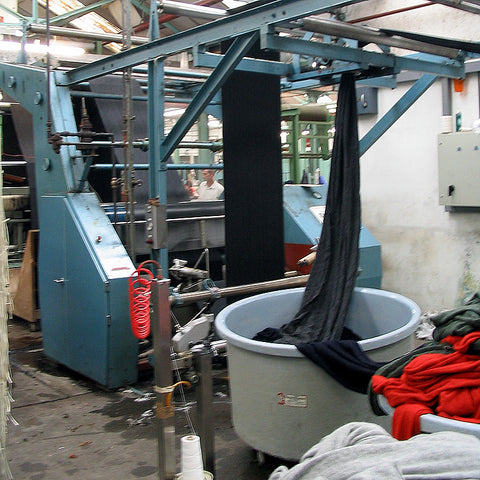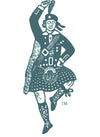
HARRIS TWEED® - THE BEST WOOL MATERIAL IN THE WORLD?
Harris Tweed® seems imbued with so many of the qualities that we associate with The Outer Hebrides in Scotland, both physical and spiritual. This magical and resilient cloth has defied categorisation, spanning many different production and design genres from Jimmy Choo Shoes to Vivien Westwood dresses to Cordings Jackets... and so on.
The history of Harris Tweed cloth is the history of revivals. But what is it about its manufacture that makes it so sought after, so strong and so desirable?
One constant in Harris Tweed production over the years has been an emphasis on quality. The processes that underlie this are enshrined by an Act of Parliament.
Harris Tweed:
- can only be woven in The Outer Hebrides, off the West Coast of Scotland
- is handwoven on treadle looms(operated by foot) in people's houses on The Islands
- is produced exclusively from virgin Cheviot wool
- is created with great pride by a few mills and individuals who oversee every process (rather than dying, spinning, weaving and finishing being done by different mills)
- is created from fleece that is dyed and then melded into different colours and shades before spinning; this unique process gives a depth to the different hues and a slight unpredictability and 'life' to each piece of cloth
- has been created on the The Islands with care and innovation over many centuries
- has its production constantly monitored by the Harris Tweed Authority regardless of who owns and runs the mill
- production naturally limited by the size of The Islands and the number of mills which makes it rare and adds extra kudos
- is legendary for its qualities of durability and water repellence.
You may have wondered how this iconic cloth is created? We took the opportunity some years ago to investigate this intriguing and involved process at Kenneth Mackenzie in Shawbost, on the Isle of Lewis. We ordered the cloth that we needed for production of our products that season, and marvelled at the skill and dedication of the team there as well as the individual weavers in their houses.
HARRIS TWEED® - HOW IT'S MADE
Only pure virgin wool is utilised in the production of Harris Tweed. This wool, from Cheviot sheep, is mainly sourced from the mainland, but can also come from local stock in the summer.
Its quality is carefully monitored and it arrives as raw fleece which has been cleaned.

The wool is washed in large vats before being dried in spin driers and dyed, still on the fleece. The irregularity of the way that the dyes bond to the fleeces is part of what gives Harris Tweed that extra dimension of depth.
Great care is taken to minimise environmental damage through low volatile organic compounds (VOC) practices.

The wool is shredded and refined by machines in a series of stages, until it is ready to become one of the base colours that form part of the many 'recipes' that are spun into the finished yarn colour ways.

The blue wool in the previous picture is part of a blend that will, after further mixing, 'carding' and 'teasing, be spun into a wonderful and subtle, orangey hued yarn, as you see below.

After Being put through mechanical, toothed rollers, that 'tease' and 'card' the shredded, blended wool, this fragile material is ready to be spun into one of the yarns that will make up the famously indestructible Harris Tweed.

The wool is now spun onto large bobbins, ready to be used as the 'warp' and 'weft' of the cloth. The process of setting up these two elements, that will form the cross weave of the Tweed, is painstakingly done by a very skilled and experienced work force.

The result of those labours is wound onto large 'beams'; the 'warp' is the large one seen in the image above, and the 'weft' the smaller. The warp will be the continuous yarn thread that runs the length of the cloth. These large beams are delivered to the hundreds of home weavers scattered across Lewis and Harris. Here you can see the Kenneth Mackenzie lorry on standby for more deliveries to the far-flung homes of the weavers.

The cloth must be woven in peoples' homes on The Islands in order for it to be called Harris Tweed. Hand-weaving is one of the things that imparts strength and quality to this tweed. The 'treadle' loom is operated by foot yet some weavers can create many metres in one day. This creates invaluable extra employment in The Outer Hebrides.

The yarn is picked up in 65-meter lengths and taken back to the workshop for the last processes. It is termed 'greasy' at this stage as it has had none of the final washing processes. It looks dishevelled at this point; an unlikely candidate for the title of 'best wool material in the world'.

It is inspected by a team of 'eagle-eyed darners' who remedy even the tiniest of flaws before the cloth makes its way on to the final stages.

The cloth is washed and ‘beaten’ in soda and soapy water to remove any impurities before being steamed and and pressed. It will also go through the ‘cropping’ process to remove fine surface hairs, giving it a finer appearance and making it more fire retardant.

The cloth is now fully ironed and finished ready to be rolled and dispatched worldwide for production into a multitude of different products of staggering variety.

One important process remains, however. The cloth is inspected by a representative of The Harris Tweed Authority, for quality and worthiness of the world famous Harris Tweed Orb symbol,This is a ‘certified trademark’ which guarantees not only provenance but also the process and quality of the cloth.
The range of products, some entirely traditional, and some at the very forefront of the fashion, that this adaptable material can be used to make is unique.
In an age where we struggle to maintain a sense of heritage and quality, Harris Tweed is the perfect blend of tradition and modernity, delicacy of hue and extraordinary toughness.
The title of Ian Lawson s marvellous book on the subject ,‘From The Land Comes The Cloth’,seems to encapsulate things perfectly!





